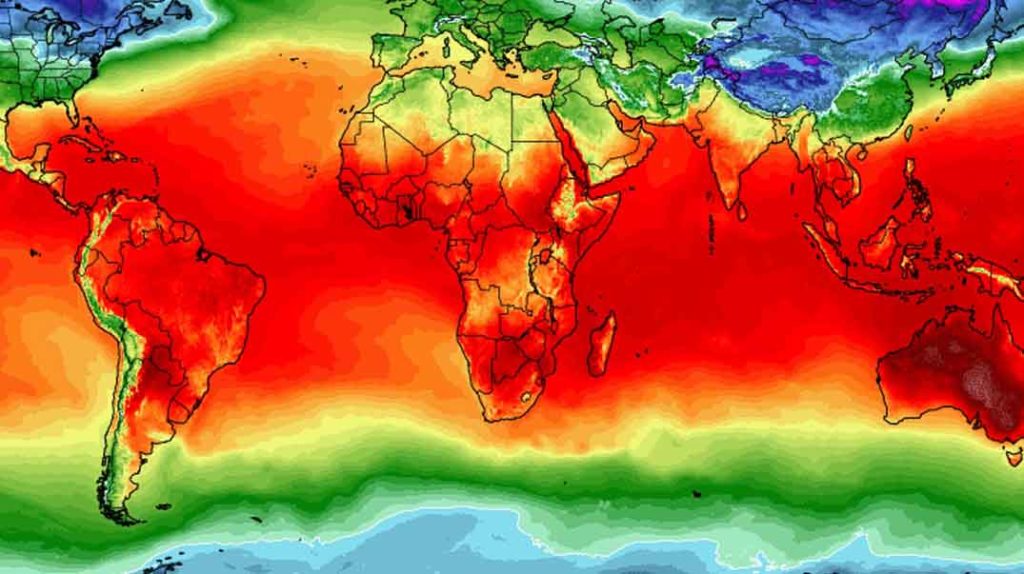The past ten years—frankly, the last five years alone—have shown a dramatic increase in extreme temperatures and precipitation leading to everything from extended droughts (which, themselves, lead to wildfires) to massive ice storms to mudslides to multiple Category 4 and 5 hurricanes. As our climate warms, temperatures and storm systems are altered; in some cases, significantly. And this has and will continue to lead to more and more severe outcomes.
But why is this happening? And is there anything that can be done to stop it?
The short answer: climate change, duh. And yes!
The long answer…well…let’s just get into it.
Weather vs. Climate
Square one: defining the difference between weather and climate. It might seem mundane or even a bit arduous, but the truth is, most people struggle to know the difference between the two terms. Luckily, we came prepared!
- Weather: short-term changes in the atmosphere (e.g., a storm)
- Climate: long-term changes in weather patterns, typically in a specific area
So, when scientists use the phrase “climate change,” it’s referring to the changes in weather patterns, temperatures, and levels of precipitation over years, and how these patterns compare to those in the decades—even centuries—that came before. These previous decades are referred to as “climate normals.” Scientists are then able to observe shifts in these patterns.
In the case of climate change, the increased release of greenhouse gases since the turn of the 20th century (in large part due to the advancement of industry and technology) has triggered significant changes in overall weather patterns around the world.
What's Causing Extreme Temperatures?
Greenhouse gases trapped in the earth’s atmosphere trap heat which, in turn, increases the surface temperature on earth. So far, Earth’s surface temperature has increased by approximately 1.2°C (or roughly 2.2°F). This trapped heat causes sporadic heating events, creating heat waves that are consistently hotter and last longer than those we’ve seen before. In fact, experiencing extreme heat and heatwaves is estimated to be ten times more likely now than it was pre-Industrial Era as a direct result of the increased greenhouse gas emissions.
According to the IPCC, “A heatwave that occurred once per decade in the pre-industrial era would happen 4.1 times a decade at 1.5°C of warming, and 5.6 times at 2°C.” Climate scientist Sonia Seneviratne suggests that an increase in temperatures higher than 2°C, “means that most years will be affected by hot extremes.”
Changes in the jet stream can also create “heat domes,” where the weather becomes stagnant—stuck in place—and instances of extreme heat sit over a region without moving for days or even weeks at a time.
The Problem with Increased Precipitation
A secondary side effect of the global temperature increase is precipitation. And lots of it. As temperatures increase, more surface water evaporates, collecting in the atmosphere and forming rainclouds. The more water vapor that exists in the atmosphere, the heavier the rainfall. As a result: Warmer Temperatures = Increased Precipitation = Increased Rainfall.
The Center for Climate and Energy Solutions estimates that for every degree of warming, water vapor in the air increases by 7%.
But it’s important to note that just because the water in one region vaporizes and forms rain clouds, it doesn’t mean that these clouds will precipitate in that same region. Clouds travel by way of jet stream and can be pushed to new locations before raining or snowing. Depending on the original climate of the region, this can lead to flooding, mudslides, sinkholes (due to shifting sediment), and more. Some climates get unusually dryer, falling into drought, while others become wetter—sometimes more so than the existing environment can withstand, which can lead to the previously mentioned issues.
Increased water vapor also leads to an increase in tropical storms and more dangerous weather systems (you can check out our article on hurricanes to learn how those are created). As the world gets hotter, the severity of these types of storms will continue to increase.
Can Extreme Heat Lead to Extreme Cold?
The short answer? Yes. Yes, it can.
Introducing the polar vortex. We won’t take a massive deep dive into the science behind it all (besides, the NOAA has done a way better job than we ever could—and with pictures!) but the short-and-sweet of it is this: both the North and South Poles are covered by something called a “polar vortex” in the atmosphere. This vortex, when stable, is made up of tightly circulating cold air that stays above a specific area, thus maintaining a consistently cold temperature.
However, scientists have discovered that as the earth and Arctic Sea waters begin to warm, the stability of these polar vortexes begins to reduce. As this happens, the polar vortex expands and starts sending frigid air southward. This can lead to extreme cold fronts and more and more severe winter storms.
10 Nonprofits Putting in the Work
So now you know a lot more about climate change and its effects on extreme temperatures. But what can be done about it? We’re looking at nonprofit organizations who make it their life and mission to fight for the environment, climate science, and working toward a healthier, cleaner earth without such extreme production of greenhouse gases.
Alaska - State
Focused on protecting Alaska’s sensitive ecosystems (which are experiencing the effects of climate change at a much faster rate than other parts of the world), Alaska Conservation Foundation works to protect public lands and waters in Alaska by promoting conservation philanthropy, directing resources to conservation organizations and initiatives, and investing in a healthy, clean future through grantmaking.
Maryland - Regional
Alliance for the Chesapeake Bay brings together states, communities, companies, and conservationists to improve lands and waters in and around the Chesapeake Bay watershed region. With a focus on forests, agriculture, green infrastructure, stewardship, and engagement, the Alliance strives to maintain, protect, and respect a healthy, resilient ecosystem for everyone who relies on these resources to live and thrive.
National
Also known as CET, the Center for EcoTechnology believes that tackling climate change requires a just and equitable transition to a low-carbon economy. Together with partners across the country, CET offers practical, economical, and environmentally friendly solutions for everyday needs, such as individual waste reduction, decarbonization, and local carbon offsets (to name just a few).
National
The Center for Neighborhood Technology or CNT has a goal of advancing sustainability in urban environments, from transportation to public policy, critical resources like land and water to the climate crisis. By identifying and analyzing urban environmental issues, CNT can utilize and advance critical initiatives that address these issues and further education about solutions.
Illinois - Regional
Working with communities to improve their environment is the primary mission of Delta Institute. Particularly in neighborhoods that have not historically had a voice or the necessary capacity to address environmental issues, Delta Institute prioritizes the wellbeing of residents throughout the Midwest. Stormwater, waste reduction and regenerative soil health are just a few areas of concern Delta Institute focuses on.
Michigan - Local
With two locations in Michigan, the Ecology Center focuses its efforts on environmental education, energy equity, air quality, climate action, and ending lead poisoning. These efforts include educating consumers, pushing corporations and Big Business to utilize clean energy, products, and services, and working alongside policymakers to establish laws that protect Michigan communities and the critical environments that support them.
Washington D.C. - Regional
Interfaith Power & Light works with congregations to save energy, go solar, purchase clean power, and support a healthier planet. With workshops, resources, and guides to help with education on clean energy as well as programs to support green food choices and healthier living, Interfaith Power & Light is helping to build a dynamic, earth-conscious community of faith.
Michigan - Local
Michigan Energy Options believes that clean energy is a key solution for a happier, healthier planet—and it should start locally. With programs in communities across Michigan, MEO drives projects that improve energy efficiency as well as implement renewable energy for neighborhoods and businesses throughout the state. From recycling events to the direct installation of clean energy technology, Michigan Energy Options helps make it happen.
International
Protect Our Winters (POW) empowers outdoor people to protect and advocate for the spaces they love. With a diverse community of scientists, creatives, athletes, and business leaders, POW aims to protect the environment through widespread education, legislative policy campaigning, advocacy, and by activating a widespread community of passionate individuals who love the environment.
Wisconsin - Local
By utilizing renewable energy, RENEW Wisconsin is helping to develop the stronger, healthier, and more vibrant Wisconsin of tomorrow. RENEW’s policies and programs encourage the use and support of all forms of renewable power—geothermal, hydropower, biogas, wind, solar, and more. By changing the way Wisconsinites think about power, RENEW is helping to support a happier, healthier planet with significantly reduced carbon emissions.
Is there an organization that should be on this list but isn’t? Send us your suggestions at nonprofits@earthshare.org. Plus, check out the other installments in our Natural Disaster series, which highlights common natural disasters, their environmental impacts, what you can do to help, and nonprofits who are already on the ground doing just that.



